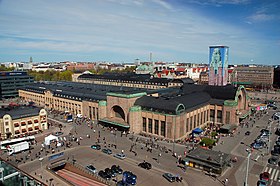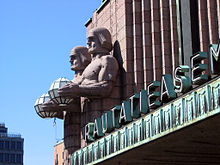Helsinki Railway Station
| Helsinki | |
|---|---|
|
Helsinki Central Station
(general view, scaffolded clock tower) |
|
| Data | |
| Design | Terminus |
| Platform tracks | 19 above ground, 2 underground |
| abbreviation | Hki |
| opening | 1860 (1919) |
| Architectural data | |
| Architectural style | National romance |
| architect | Eliel Saarinen |
| location | |
| City / municipality | Helsinki |
| Country | Finland |
| Coordinates | 60 ° 10 ′ 19 ″ N , 24 ° 56 ′ 29 ″ E |
| Railway lines | |
|
|
| List of train stations in Finland | |
The Helsinki railway station ( Finnish Helsinki asema ), also known as Helsinki Central ( Finnish päärautatieasema Helsingin , Swedish Helsinki central station ), is the central hub of national and city transport in the Helsinki region and a well-known landmark of the city. It is the home station of the Finnish state railway VR and the terminus of all lines of local rail transport in the Helsinki region .
location
The station is designed above ground as a terminal station , the tracks are only partially covered. Long-distance trains end in the southern, covered area of the station, local transport to the Helsinki capital region runs from the northern, uncovered platforms.
There are two bus stations right in front of the train station, one on the station square ( Rautatientori) and one on Elielplatz (Elielinaukio) . Numerous city and regional bus routes and the Helsinki tram depart from these . The Rautatientori underground station is the busiest station on the Helsinki Metro .
history
In 1860, the first train station in Helsinki was built by architect Carl Albert Edelfelt . However, this quickly turned out to be too small and so Eliel Saarinen's proposal emerged as the winner of the architecture competition held in 1904 . The original design envisaged a reception building in neo-Romanesque style. That received criticism. Eliel Saarinen revised his design and found a clearer design language with elements of Art Nouveau and neoclassicism . It took 15 years to build, and the new station was inaugurated on March 5, 1919.
When the new train station was no longer able to cope with the growing traffic over time, it was gradually expanded with new platforms. Since there was no more space in the actual station, the new platforms were laid out in the open immediately to the north, on both sides of the old tracks. These are today's platforms 1–3 (east of the old tracks) and 12–19 (west).
In the 1960s, the underground shopping arcade Asematunneli (station tunnel) was built, under which the underground station was established in 1982.
As part of the renovation work at the beginning of the 21st century, the original eight platforms (today's numbering 4–11) were subsequently given the glass roofs already planned by the architect. An underpass was also built north of the station building, at the level of the additional platforms, which connects the platforms with each other and also enables easier passage through the station area. In addition, new business areas were opened in the west wing and a new building for the Holiday Inn hotel was erected above platforms 12-19 .
architecture
Helsinki Central Station is considered to be Saarinen's main plant. The facade is made of Finnish granite , special features are the clock tower and the statues by Emil Wikström next to the main entrance . These statues are repeatedly used in modern advertising, they are considered one of the symbols of Helsinki. The various roof structures and large wall openings are designed as round arches; the building has comparatively many and large windows, which makes the station appear quite bright.
From the Asematunneli , large parts of the city center can be reached underground through a branched network of tunnels, passages, shopping centers and parking garages (some of which are designed as shelters ).
Others
The station also contains a prince's room originally intended as a waiting area for the Russian tsar . The station was only completed after the murder of the last tsar .
literature
- Richard Deiss: Vane Cathedral and Sugar Beet Station. A short story about 200 European train stations . BoD , Norderstedt 2010, p. 12, ISBN 978-3-8391-2913-5 (4th edition 2013: … Little stories about 222 train stations in Europe. ).
Web links
Individual evidence
- ^ Railway network statement 2021 (PDF). Väylä - Finnish Transport Infrastructure Agency, 2019, Appendix 3B / 4; accessed on June 3, 2020.





